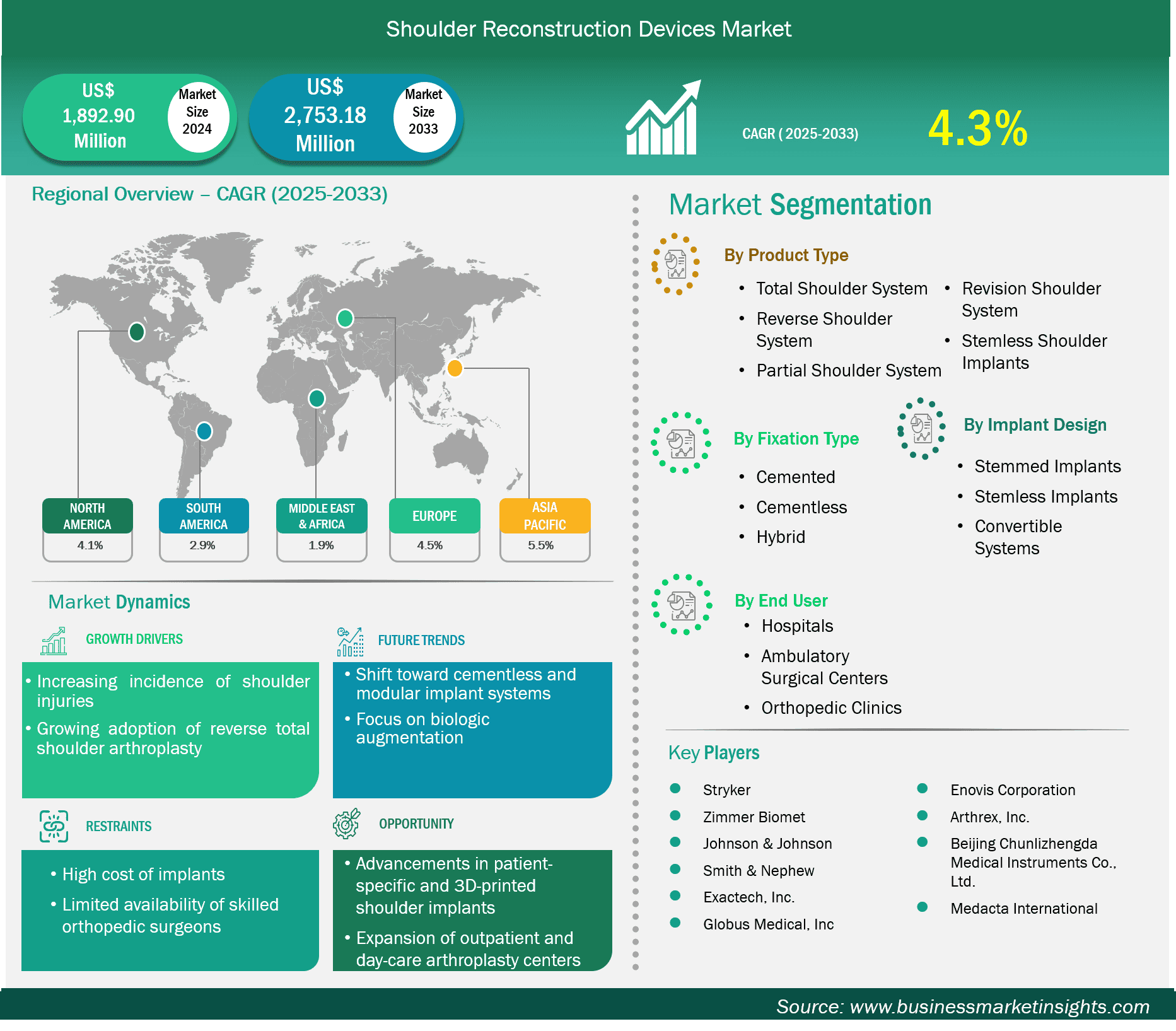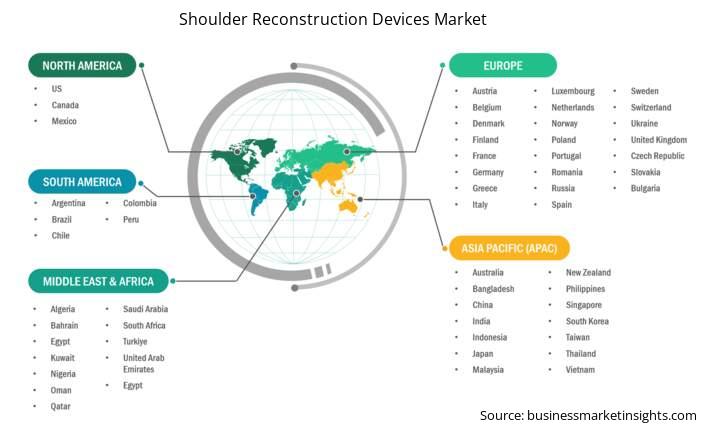Shoulder Reconstruction Devices Market Outlook (2022-2033)
No. of Pages: 200 | Report Code: BMIPUB00031761 | Category: Life Sciences
No. of Pages: 200 | Report Code: BMIPUB00031761 | Category: Life Sciences
The shoulder reconstruction devices market size is expected to reach US$ 2,753.18 million by 2033 from US$ 1,892.90 million in 2024. The market is estimated to record a CAGR of 4.3% from 2025 to 2033.
The market for shoulder reconstruction devices is increasingly growing, driven by higher incidences of rotator cuff injury, arthritis, and fractures, particularly in the active population and the aging population. Reverse total shoulder arthroplasty is increasingly in demand for reconstructive and degenerative cases, enhancing mobility and outcomes. Technology in implant development, materials, and minimally invasive techniques is boosting surgical outcomes and recovery rates. While the market remains smaller than hip and knee segments, increasing awareness and expanding orthopedic capabilities are fuelling adoption.
In line with the adoption rate, the global shoulder reconstruction devices market stood at US$ 1,892.90 million in 2024 and is expected to reach US$ 2,753.18 million by 2033. Emerging markets also are being fuelled by better healthcare access and expanding procedural volumes. The leaders are making investments in innovation, education of surgeons, and digital surgical solutions to address increasing demand and improve long-term outcomes in shoulder joint reconstruction.

Key segments that contributed to the derivation of the shoulder reconstruction devices market analysis are product type, fixation type, implant design, and end user.
Increasing incidence of shoulder injuries
The rising frequency of shoulder injuries is one of the major growth drivers for the shoulder reconstruction devices market. Shoulder injuries like rotator cuff tears, dislocation, and fractures are common in older people, athletes, and industrially active workers. Overuse, repetitive strain, and degeneration with age result in joint wear and soft tissue injury leading to pain and functional loss. When conservative treatment fails, surgery is necessary, driving the demand for shoulder reconstruction implants. Better diagnostic efficacy and heightened awareness have also led to earlier diagnosis and appropriate surgical intervention. With the growing cases of shoulder injury among people of all ages, demand for precise, anatomically accurate implants continues to rise, driving innovation and business growth in this niche orthopedic segment.
Growing adoption of reverse total shoulder arthroplasty
There is a rapid growth in the adoption of reverse total shoulder arthroplasty (RTSA) for complex shoulder pathology, driving significant expansion in the shoulder reconstruction market. RTSA is distinguished by its intent to overcome deficient rotator cuff function by altering joint mechanics and is used in patients with massive cuff tears, arthritis, or failed prior surgeries. Physician are adopted this reverse total shoulder arthroplasty method as it offers advantages in restoring function, enhancing stability, and alleviating pain in difficult situations. Advances in implant technology and surgical techniques have enhanced procedural outcomes, making RTSA safer and more predictable. Its growing success in older, active patients has expanded beyond specialty indications. With growing clinical awareness and patient demand, RTSA is emerging as a leading growth area in shoulder arthroplasty, prompting device manufacturers to invest in dedicated implants and surgical tools tailored for this procedure.
By product type, the shoulder reconstruction devices market is segmented into total shoulder system, reverse shoulder system, partial shoulder system, revision shoulder system and stemless shoulder implants. The total shoulder system segment dominated the market in 2024. Total shoulder arthroplasty (TSA) is the most widely performed procedure for osteoarthritis, avascular necrosis, and rotator cuff disease when the joint surface is intact. It is well-established and has strong clinical outcomes.
By fixation type, the shoulder reconstruction devices market is segmented into cemented, cementless, and hybrid. The cemented segment dominated the market in 2024. Cemented fixation is preferred in shoulder arthroplasty, especially for glenoid components, due to better initial stability. Humeral components are sometimes press-fit, but overall cemented remains most used.
By implant design, the market is segmented into stemmed implants, stemless implants and convertible systems. The stemmed implants segment held the largest share of the market in 2024. Stemmed implants provide long-term fixation and are more commonly used than stemless systems, particularly in patients with poor bone quality or in revisions. Most total and reverse shoulder systems are stemmed
By end user, the market is segmented into hospitals, ambulatory surgical centers, and orthopedic clinics. The hospitals segment held the largest share of the market in 2024. The majority of shoulder arthroplasty surgeries—especially complex or reverse procedures—are performed in hospital settings due to the need for surgical infrastructure, recovery services, and complication management.
Shoulder Reconstruction Devices Market Report Highlights
Report Attribute
Details
Market size in 2024
US$ 1,892.90 Million
Market Size by 2033
US$ 2,753.18 Million
Global CAGR (2025 - 2033) 4.3%
Historical Data
2022-2023
Forecast period
2025-2033
Segments Covered
By Product Type
By Fixation Type
By Implant design
By End User
Regions and Countries Covered
North America
Europe
Asia-Pacific
South and Central America
Middle East and Africa
Market leaders and key company profiles
Shoulder Reconstruction Devices Market Report Coverage and Deliverables
The "Shoulder Reconstruction Devices Market Size and Forecast (2022–2033)" report provides a detailed analysis of the market covering below areas:

The geographical scope of the shoulder reconstruction devices market report is divided into five regions: North America, Asia Pacific, Europe, Middle East & Africa, and South & Central America. The shoulder reconstruction devices market in Asia Pacific is expected to grow significantly during the forecast period.
The shoulder reconstruction devices market is evaluated by gathering qualitative and quantitative data post primary and secondary research, which includes important corporate publications, association data, and databases. A few of the key developments in the shoulder reconstruction devices market are:
The Shoulder Reconstruction Devices Market is valued at US$ 1,892.90 Million in 2024, it is projected to reach US$ 2,753.18 Million by 2033.
As per our report Shoulder Reconstruction Devices Market, the market size is valued at US$ 1,892.90 Million in 2024, projecting it to reach US$ 2,753.18 Million by 2033. This translates to a CAGR of approximately 4.3% during the forecast period.
The Shoulder Reconstruction Devices Market report typically cover these key segments-
The historic period, base year, and forecast period can vary slightly depending on the specific market research report. However, for the Shoulder Reconstruction Devices Market report:
The Shoulder Reconstruction Devices Market is populated by several key players, each contributing to its growth and innovation. Some of the major players include:
The Shoulder Reconstruction Devices Market report is valuable for diverse stakeholders, including:
Essentially, anyone involved in or considering involvement in the Shoulder Reconstruction Devices Market value chain can benefit from the information contained in a comprehensive market report.